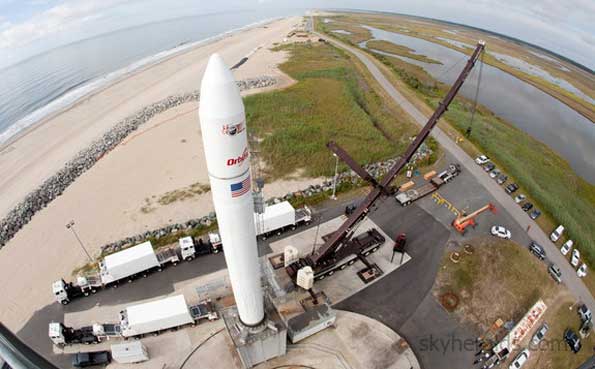NASA`s Minotaur V Rocket Set to Launch
Inaugural Launch of Minotaur V to Deploy 45th Spacecraft by Orbital’s Minotaur Product Line
Orbital Sciences Corporation, one of the world’s leading space technology companies, announced today that it is in final preparations for the launch of NASA’s Lunar Atmosphere and Dust Environment Explorer (LADEE) spacecraft aboard its new Minotaur V rocket. The vehicle is scheduled to be launched from NASA’s Wallops Flight Facility in eastern Virginia on Friday, September 6, 2013 at approximately 11:27 p.m. EDT. LADEE will mark the first lunar launch from the NASA Wallops facility and Orbital’s first Minotaur rocket launch of a payload that will travel beyond low-Earth orbit.
The Minotaur V is a five-stage space launch vehicle designed, built and operated by Orbital for the U.S. Air Force. It uses three decommissioned Peacekeeper government-supplied booster stages that Orbital combines with commercial motors for the upper two stages to produce a low-cost rocket for launching smaller spacecraft into low-Earth orbit and higher-energy trajectories, such as the trans-lunar flight of the LADEE mission.
“The Minotaur V design builds on Orbital’s proven systems engineering, production, test and flight operations supporting the Minotaur family of rockets, creating another cost-effective launch alternative for U.S. government space missions,” said Mr. Lou Amorosi, Senior Vice President of Orbital’s Small Space Launch Vehicle business. “We look forward to the successful launch of the LADEE orbiter and the opportunity to continue supporting NASA in its exploration and science missions.”
Under the Orbital/Suborbital Program (OSP) contract, which is managed by the U.S. Air Force Space and Missile Systems Center (SMC), Space Development and Test Directorate (SMC/SD) Launch Systems Division (SMC/SDL) located at Kirtland Air Force Base, New Mexico, Orbital designs, integrates, tests and provides launch services to orbit with the Minotaur I, IV, V and VI rockets, as well as other suborbital capabilities with the Minotaur II and III configurations. The company has launched a total of 23 Minotaur rockets with a 100% success record dating back to January 2000.
Employing a combination of U.S. government-supplied rocket motors and Orbital’s proven commercial launch technologies, the Minotaur family of launchers provides reliable and low-cost access to space for government-sponsored payloads. The rockets are specifically designed to be capable of launching from all major U.S. spaceports, including government and commercial launch sites in Alaska, California, Virginia and Florida. Orbital’s use of standardized avionics and subsystems, mature processes and experienced personnel make Minotaur rockets both reliable and cost-effective for U.S. government customers.
In addition to the Minotaur V rocket, the product line includes:
Minotaur I – The initial member of the Minotaur family, the Minotaur I is a four-stage space launch configuration that can place up to 1,300 lbs. into low-Earth orbit. It was originally launched in January 2000 and has conducted a total of 10 successful launches to date.
Minotaur II – A three-stage suborbital rocket, the Minotaur II is used as a target vehicle for testing U.S. missile defense systems and related missions. This configuration has performed eight successful launches to date.
Minotaur III – A three-stage suborbital rocket, Minotaur III can deliver suborbital technology demonstration payloads of up to 6,500 lbs. or serve as a target vehicle for testing U.S. missile defense systems and similar missions.
Minotaur IV – A heavier-lift four-stage space launch vehicle using retired Peacekeeper rocket motors, the Minotaur IV is capable of launching satellites weighing up to 3,800 lbs. into low-Earth orbit. Five successful launches have been conducted with this configuration.
Minotaur VI – An evolutionary version of the flight-proven Minotaur IV, the Minotaur VI provides a highly-capable and cost-effective launcher for U.S. Government-sponsored spacecraft of up to 7,000 lbs. into low-Earth orbit. The combination of four government-furnished solid rocket stages, a commercial solid rocket upper stage, and Orbital’s flight-proven systems and processes provide unmatched value and performance.

